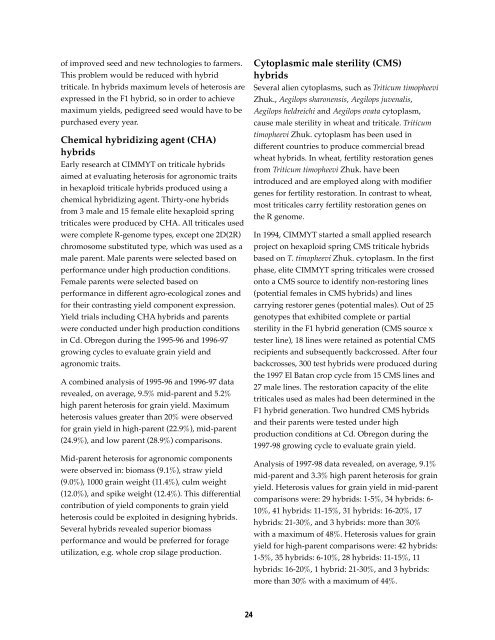Research Highlights of the CIMMYT Wheat Program 1999-2000
Research Highlights of the CIMMYT Wheat Program 1999-2000
Research Highlights of the CIMMYT Wheat Program 1999-2000
Create successful ePaper yourself
Turn your PDF publications into a flip-book with our unique Google optimized e-Paper software.
<strong>of</strong> improved seed and new technologies to farmers.<br />
This problem would be reduced with hybrid<br />
triticale. In hybrids maximum levels <strong>of</strong> heterosis are<br />
expressed in <strong>the</strong> F1 hybrid, so in order to achieve<br />
maximum yields, pedigreed seed would have to be<br />
purchased every year.<br />
Chemical hybridizing agent (CHA)<br />
hybrids<br />
Early research at <strong>CIMMYT</strong> on triticale hybrids<br />
aimed at evaluating heterosis for agronomic traits<br />
in hexaploid triticale hybrids produced using a<br />
chemical hybridizing agent. Thirty-one hybrids<br />
from 3 male and 15 female elite hexaploid spring<br />
triticales were produced by CHA. All triticales used<br />
were complete R-genome types, except one 2D(2R)<br />
chromosome substituted type, which was used as a<br />
male parent. Male parents were selected based on<br />
performance under high production conditions.<br />
Female parents were selected based on<br />
performance in different agro-ecological zones and<br />
for <strong>the</strong>ir contrasting yield component expression.<br />
Yield trials including CHA hybrids and parents<br />
were conducted under high production conditions<br />
in Cd. Obregon during <strong>the</strong> 1995-96 and 1996-97<br />
growing cycles to evaluate grain yield and<br />
agronomic traits.<br />
A combined analysis <strong>of</strong> 1995-96 and 1996-97 data<br />
revealed, on average, 9.5% mid-parent and 5.2%<br />
high parent heterosis for grain yield. Maximum<br />
heterosis values greater than 20% were observed<br />
for grain yield in high-parent (22.9%), mid-parent<br />
(24.9%), and low parent (28.9%) comparisons.<br />
Mid-parent heterosis for agronomic components<br />
were observed in: biomass (9.1%), straw yield<br />
(9.0%), 1000 grain weight (11.4%), culm weight<br />
(12.0%), and spike weight (12.4%). This differential<br />
contribution <strong>of</strong> yield components to grain yield<br />
heterosis could be exploited in designing hybrids.<br />
Several hybrids revealed superior biomass<br />
performance and would be preferred for forage<br />
utilization, e.g. whole crop silage production.<br />
Cytoplasmic male sterility (CMS)<br />
hybrids<br />
Several alien cytoplasms, such as Triticum timopheevi<br />
Zhuk., Aegilops sharonensis, Aegilops juvenalis,<br />
Aegilops heldreichi and Aegilops ovata cytoplasm,<br />
cause male sterility in wheat and triticale. Triticum<br />
timopheevi Zhuk. cytoplasm has been used in<br />
different countries to produce commercial bread<br />
wheat hybrids. In wheat, fertility restoration genes<br />
from Triticum timopheevi Zhuk. have been<br />
introduced and are employed along with modifier<br />
genes for fertility restoration. In contrast to wheat,<br />
most triticales carry fertility restoration genes on<br />
<strong>the</strong> R genome.<br />
In 1994, <strong>CIMMYT</strong> started a small applied research<br />
project on hexaploid spring CMS triticale hybrids<br />
based on T. timopheevi Zhuk. cytoplasm. In <strong>the</strong> first<br />
phase, elite <strong>CIMMYT</strong> spring triticales were crossed<br />
onto a CMS source to identify non-restoring lines<br />
(potential females in CMS hybrids) and lines<br />
carrying restorer genes (potential males). Out <strong>of</strong> 25<br />
genotypes that exhibited complete or partial<br />
sterility in <strong>the</strong> F1 hybrid generation (CMS source x<br />
tester line), 18 lines were retained as potential CMS<br />
recipients and subsequently backcrossed. After four<br />
backcrosses, 300 test hybrids were produced during<br />
<strong>the</strong> 1997 El Batan crop cycle from 15 CMS lines and<br />
27 male lines. The restoration capacity <strong>of</strong> <strong>the</strong> elite<br />
triticales used as males had been determined in <strong>the</strong><br />
F1 hybrid generation. Two hundred CMS hybrids<br />
and <strong>the</strong>ir parents were tested under high<br />
production conditions at Cd. Obregon during <strong>the</strong><br />
1997-98 growing cycle to evaluate grain yield.<br />
Analysis <strong>of</strong> 1997-98 data revealed, on average, 9.1%<br />
mid-parent and 3.3% high parent heterosis for grain<br />
yield. Heterosis values for grain yield in mid-parent<br />
comparisons were: 29 hybrids: 1-5%, 34 hybrids: 6-<br />
10%, 41 hybrids: 11-15%, 31 hybrids: 16-20%, 17<br />
hybrids: 21-30%, and 3 hybrids: more than 30%<br />
with a maximum <strong>of</strong> 48%. Heterosis values for grain<br />
yield for high-parent comparisons were: 42 hybrids:<br />
1-5%, 35 hybrids: 6-10%, 28 hybrids: 11-15%, 11<br />
hybrids: 16-20%, 1 hybrid: 21-30%, and 3 hybrids:<br />
more than 30% with a maximum <strong>of</strong> 44%.<br />
24

















